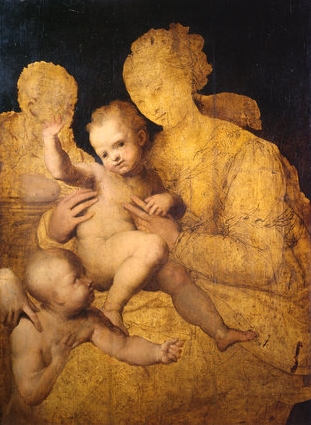Unfinished Sympathy: Should Communication Lose its Gloss?
I own an unfinished painting. It’s a portrait of a young blond-haired man staring rather dreamily into the middle distance. The dealer suggested that the artist wasn’t of the highest order and, when he saw how well he’d done at this intermediate stage, he decided it was best to stop there. Perhaps this story ought to have put me off purchasing, but actually it charmed me.
I recently attended a small exhibition of ‘unfinished’ art. The show at the Courtauld Gallery in London (which runs until 20 September) features unfinished paintings, sculpture, drawings and prints from the Renaissance to the early twentieth century. Why were these works unfinished?
In a few instances the artist died before completing a piece. Sometimes the painter was simply not satisfied with how things had turned out. Monet revisited his Vase of Flowers repeatedly over forty years, and experts have detected areas where he has painted over dried paint.
Sometimes the moment has passed. Manet’s Au Bal seems to have caught a woman turning away to leave the room. And there’s a small Turner watercolour where drops of rainwater have been detected on the paper. He obviously had to make a run for it.
Unfinished artworks have been treasured by teaching academies over the years as they shed light on technique. But more than this. In the first century AD the Roman author Pliny the Elder wrote that incomplete work was particularly precious because it lets us see into the artist’s mind.
There’s certainly something beguiling about the unfinished. It has an immediacy, a freshness and transience that elude finished work. We feel closer to the artist; to the act of creation. Unfinished art seems somehow particularly fragile, physical and human. Perhaps because we are ourselves merely works in progress. We are all unfinished. In Perino del Vaga’s Holy Family with Saint John the Baptist, the Virgin Mary is only present in outline. It is rather haunting as a result. It suggested to me the tragic inevitability of death within the family.
The Courtauld exhibition also highlights how sometimes we just don’t know whether a painting is finished or not. Does a signature indicate completion? The Impressionists attracted a lot of criticism for displaying work that looked incomplete. Degas’ Woman at a Window seems unfinished in many respects, but Degas ‘signed it off.’ For the artist Sickert, who bought the painting, this was his finest work.
‘There is a great difference between a work that is complete and one that is finished. The complete work is one that conveys the vision of the artist, the finished one is often glossed.’
Charles Baudelaire
I wonder does too much of our output in the communications industry appear glossed? Does it lose some of its humanity in endless post-production? Are our images air-brushed out of all recognition?
What would happen if we stopped short of the impeccably polished? What if we adopted a looser, more informal style?
What if we exposed the process of creation, the workings in the margin?
There’s something stale and artificial about much modern brand communication. Endless hours of analysis and over-thought have wrung the intimacy and spontaneity out of ideas. They’ve created a distance, an absence, an insincerity.
We’re all enamoured of authenticity nowadays, but there’s nothing authentic about perfection.
No. 47



